Local elections 2024: Mayor of London
Sadiq Khan is standing for mayor of London for the third time. Who are the other mayoral candidates? How does devolution to London work?
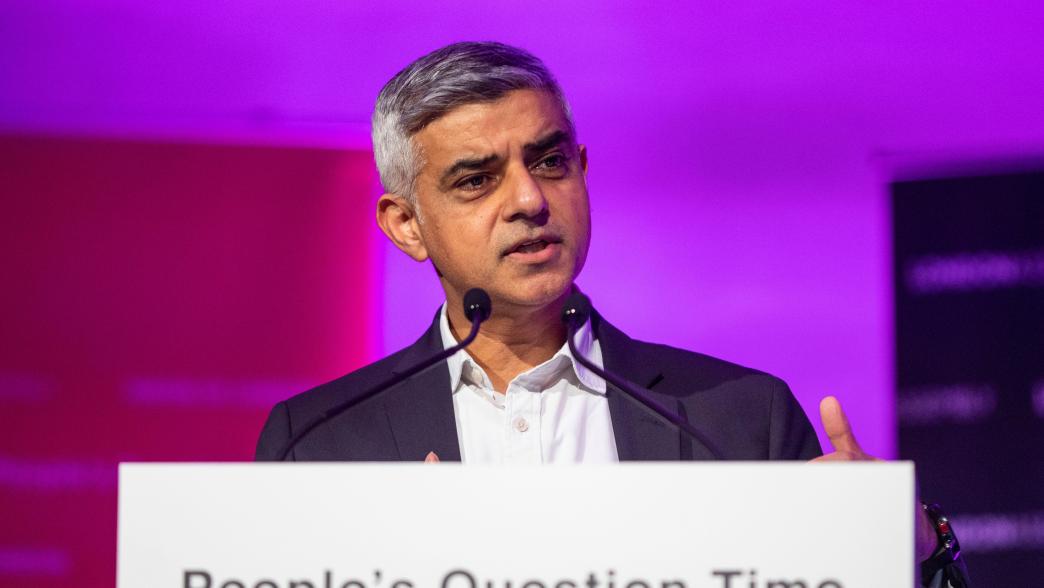
On 2 May 2024, an election will take place to determine the next mayor of London, who will lead the Greater London Authority (GLA) and oversee a budget of over £20bn. For the first time, this election is taking place using the first-past-the-post system. On the same day, Londoners will also vote for members of the London Assembly – the body responsible for holding the mayor to account.
What is the history of devolution to London?
The abolition of the Greater London Council (GLC) in 1986 left London without a directly elected government for the first time in almost 100 years. In 1997 the Labour party came to office with a commitment to re-establishing an elected tier of government for London. 36 New Labour, Because Britain Deserves Better, election manifesto, 1997, labourmanifesto.com/1997/1997-labour-manifesto.shtml
Tony Blair’s government published its proposals in March 1998, with a referendum held in May 1998 which returned a vote of 72% in favour of the proposals. The Greater London Authority Act 1999 was subsequently passed and the first mayoral and Assembly elections were held in May 2000. Further powers have been conferred on the mayor on several occasions since 2000.
The first mayoral election was won by Ken Livingstone, the former leader of the GLC, who stood as an independent candidate. In 2004, he was re-elected as a Labour candidate. Boris Johnson, the Conservative party candidate, won against Livingstone in 2008 and again in 2012.
In 2016, Tooting MP and former minister Sadiq Khan became the third mayor of London, defeating the Conservatives’ Zac Goldsmith. He was re-elected in 2021, in an election delayed by the Covid-19 pandemic, winning 55% of the vote after second preference votes were counted.
Local and mayoral elections 2024
On Thursday 2 May, voters across England and Wales will head to the polls in a major set of mayoral and local elections. Keep up with our latest content, events and analysis on why these elections matter and the results when they come.
Find out more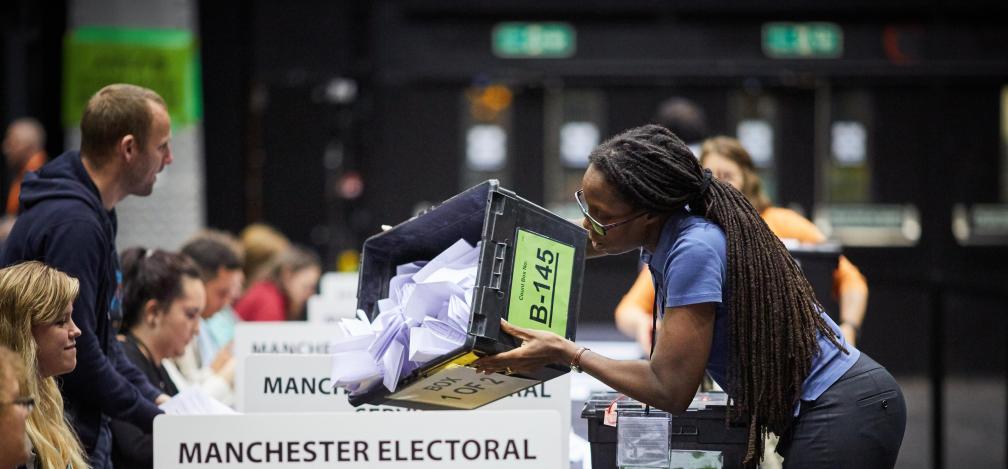
Who are the candidates for the May 2024 London mayoral election?
Incumbent Labour mayor Sadiq Khan is standing for a third time. His main opponent is Conservative candidate, Susan Hall, who led the Conservative group on the London Assembly between 2019 and May 2023.
Other candidates include the Green party’s Zoe Garbett, a local councillor in Dalston, the Liberal Democrats’ Rob Blackie, who has previously stood for the London Assembly, and Reform’s Howard Cox.
Eight further candidates have declared that they are standing, including the Social Democratic Party’s Amy Gallagher, the Animal Welfare Party’s Femy Amin, Britain First’s Nick Scanlon, London Real Party’s Brian Rose as well as independent candidates Natalie Campbell, Tarun Ghulati, Andreas Michli and satirical candidate Count Binface.
How is the mayor of London elected?
Following the Elections Act 2022, the 2024 election will take place using the first-past-the-post system. 45 Elections Act 2022, www.legislation.gov.uk/ukpga/2022/37/contents/enacted Previous elections were decided by the ‘supplementary vote’ where voters could express a first and second preference. No mayoral candidate has ever won over 50% of first preferences, but the leading candidate in the first round was always elected mayor after second preferences were considered, meaning that the winner would have been the same under first-past-the-post.
Turnout in London elections has broadly risen over time, from a low of 34% at the first vote in 2000 to a record 46% in 2016. In 2021, this dropped to 42% - in part caused by a substantial rise in the number of spoilt ballots.
What are the powers of the mayor of London?
The mayor acts as the strategic authority for London and sets the budget for the GLA (subject to assembly approval). The mayor has defined powers over certain policy areas and general powers of competence for promoting the improvement of the environment, economic development and social development.
These general powers cannot be used to deliver functions such as education or social services that are the responsibility of local government. Unlike the mayoral combined authority model in other parts of England, London’s 33 local authorities do not form part of the GLA, although the mayor works closely with them.
The mayor is responsible for setting the strategic direction and priorities for the Metropolitan Police through the mayor’s Office for Policing and Crime. Operational decisions remain the responsibility of the Met commissioner, who is appointed by the home secretary following consultation with the mayor. The mayor also sets the Met’s budget in consultation with the commissioner.
The mayor has similar powers over the London Fire Brigade, setting its budget, approving the London Safety Plan, and appointing the fire commissioner.
The mayor has to produce strategies for transport, economic development, health, housing, planning, environment, and culture. But the mayor only has executive responsibilities over transport, economic development and housing: in other policy areas the mayor delivers their strategies by convening partnerships and providing funding.
A central function of the mayor is to oversee Transport for London (TfL). Alongside public transport functions, TfL is responsible for London’s strategic road network, road user charging schemes (such as the Ultra Low Emissions Zone), regulating taxis and private hire vehicles, and programmes to encourage active and sustainable travel. TfL also provides funding for local authorities to enact the mayor’s Transport Strategy, through the submission of Local Implementation Plans (LIPs).
Another important mayoral responsibility is to produce the London Plan – a spatial development strategy which sets out a vision for how London will develop over a 20-25 year period. The most recent plan was developed in 2021. The mayor also allocates funding from central government’s affordable homes programme. 46 Greater London Authority, Homes for Londoners: Affordable Homes Programmes, www.london.gov.uk/programmes-strategies/housing-and-land/homes-londoners-affordable-homes-programmes
The mayor has the power to establish mayoral development corporations (MDCs) to drive urban regeneration in specific areas. There are currently two MDCs: the London Legacy Development Corporation (LLDC), which covers the Olympic Park, and the Old Oak and Park Royal Development Corporation (OPDC), introduced to promote development around an interchange station between the Elizabeth Line and HS2.
The mayor also acts as ‘spokesperson for London’, both in public debate and in negotiations with central government, for instance to secure additional funding. 47 Bogdanor, Vernon, Beyond Brexit: Britain’s Unprotected Constitution, 2019
Successive mayors have asked central government to devolve more powers to the GLA. In particular, reports published in 2013 and 2017 by the London Finance Commission – a group of experts assembled by the mayor – made the case for the devolution of fiscal powers including council tax, business rates, and stamp duty. 48 London Finance Commission, Raising the Capital, May 2013, www.london.gov.uk/sites/default/files/gla_migrate_files_destination/Raising%20the%20capital_0.pdf 49 London Finance Commission, Devolution: a capital idea, January 2017, www.london.gov.uk/sites/default/files/devolution_-_a_capital_idea_lfc_2017.pdf These proposals have not been accepted by the UK government, with the partial exception of the capital participating in the pilots for business rates retention. 50 London Councils, Business Rates Update 2021, www.londoncouncils.gov.uk/members-area/member-briefings/local-government-finance/business-rates-update
What is the size of the Greater London Authority budget – and where is the money spent?
The GLA has an annual budget for day-to-day spending of £17.5bn. In the 2024/25 budget, over half (£9.6bn) was allocated to TfL. The second largest spending area is policing, with £4.8bn allocated. Other areas of mayoral spending include £580m on Communities and Skills projects, £140m on Good Growth (including a fund for regeneration projects) and £78m on Housing and Land. 51 Greater London Authority, Consolidated Budget and Component Budgets 2024-25, www.london.gov.uk/sites/default/files/2024-03/Mayors-Final-Consolidated-Budget-for-2024-25.pdf
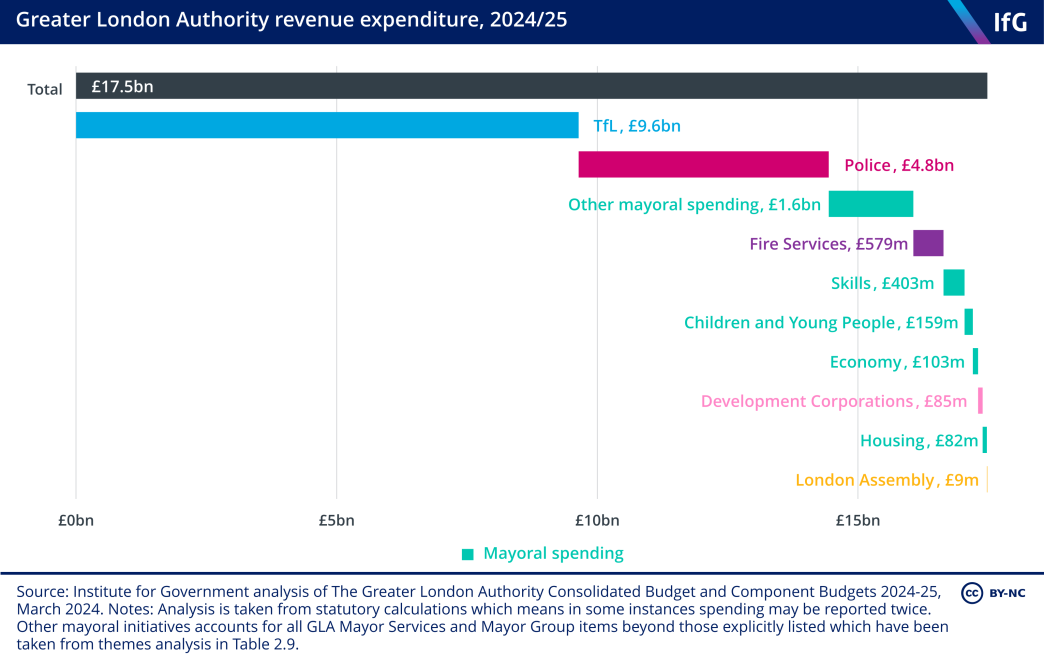
The mayor is required by law to prepare a capital spending plan alongside the budget. Latest plans indicate that the GLA expects to spend an average of £4bn a year on capital projects until 2028. 52 Greater London Authority, The Mayor of London’s Capital Spending Plan 2024-25, www.london.gov.uk/sites/default/files/2024-02/Mayor%20Capital%20Spending%20Plan%202024-25.pdf Major projects include Crossrail and delivering the government’s Affordable Homes Programme.
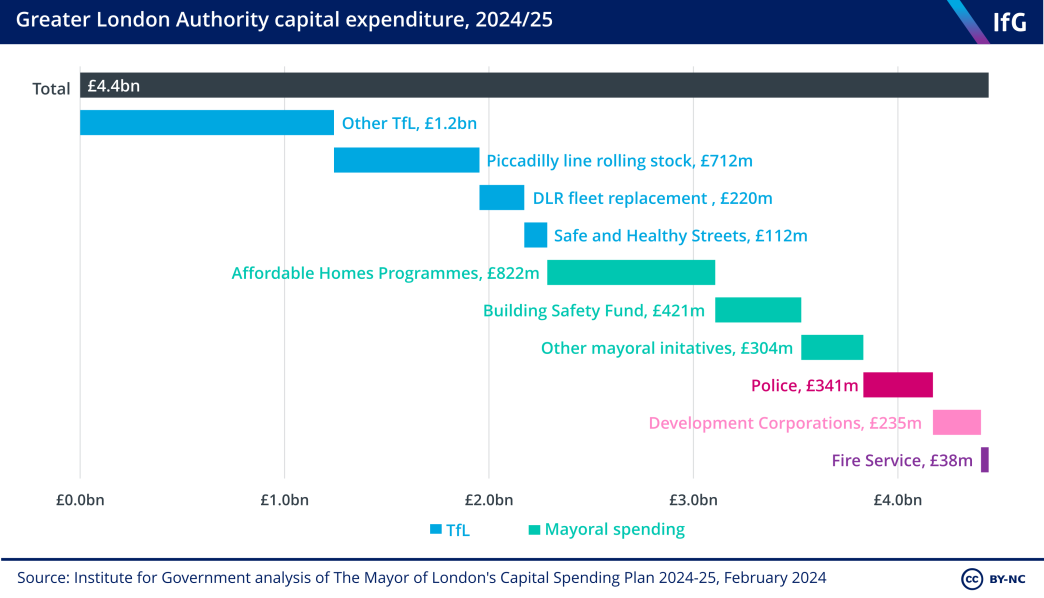
The Greater London Authority employs 1,300 people, with staffing costs accounting for £106m in 2024/25.
How is the Greater London Authority funded?
The GLA is funded by a combination of central government grants, business rates, council tax, and other fares, charges and sources of income.
Some elements of the GLA are funded via direct grants from central government. For example, the GLA receives a core police grant from the Home Office worth £2.4bn. In total, grants from central government for day-to-day spending amounts to around £3.7bn. 61 Greater London Authority, Consolidated Budget and Component Budgets 2024-25
The GLA participates in the Business Rates Retention Scheme, enabling it to retain 37% of business rates revenue (initially set at 20% in 2013). 62 Greater London Authority, The Mayor of London’s Capital Spending Plan 2024-25 In 2024/25 this scheme is estimated to bring in £3.6bn in revenue. 63 Greater London Authority, Consolidated Budget and Component Budgets 2024-25
Londoners pay a council tax precept – collected by London’s boroughs and the City of London Corporation – to help fund the GLA and its functional bodies. The level of the precept is determined by the mayor’s budget. In 2024/25, the precept will deliver £1.5bn to the GLA. 64 Greater London Authority, Consolidated Budget and Component Budgets 2024-25
For 2024/25, the GLA has budgeted for fares, charges and other income sources to raise £8.1bn. Of this, TfL is expected to account for £7.1bn made up of passenger fares (£5.5bn), road charges (£988m) and advertising revenue (£136m). 65 Greater London Authority, The Mayor of London’s Capital Spending Plan 2024-25
The government has also provided additional funding for TfL since March 2020, when fares income dropped during the pandemic. But the current funding settlement is due to end on 31 March 2024, when TfL is expected to return to being financially self-sustaining for all activities other than major capital projects. 66 Department for Transport, Transport for London – Long-term Funding Settlement, assets.publishing.service.gov.uk/media/631077998fa8f504c4f681c6/tfl-long-term-funding-settlement-30-august-2022.pdf
The mayor can also raise money for the GLA through the Mayoral Community Infrastructure Levy (MCIL), a charge payable on a per-square-metre basis on new developments in London. In 2022/23, the MCIL raised £168m, and since its introduction in 2012 it has raised just under £1.2bn. 67 Greater London Authority, Community Infrastructure Levy Annual Return Overview, www.london.gov.uk/sites/default/files/2023-10/MCIL%20Annual%20Return%20Overview%20%282012-2023%292.pdf The MCIL is currently being used to repay financing for the Elizabeth Line. 68 Greater London Authority, Mayoral Community Infrastructure Levy 2022 Biennial Review, www.london.gov.uk/sites/default/files/2023-10/MCIL%20Biennial%20Review%202022%20-%20FINAL.pdf
The GLA and its functional bodies can also borrow money, within limits subject to the Prudential Code – a framework aimed at ensuring the capital spending of local authorities is affordable.
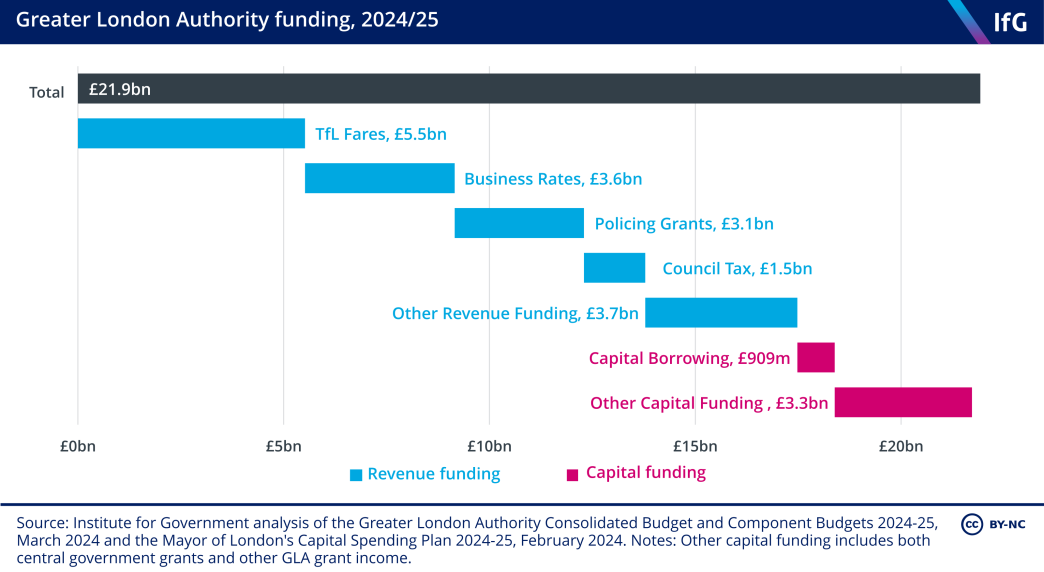
How does the GLA compare to the rest of the UK in terms of social and economic outcomes?
Across many social and economic indicators, London performs better than the UK average. London has the highest productivity of any UK region and a much higher proportion of the population has at least an A-Level or equivalent qualification (71% vs 61%). Approximately half of the population take public transport to work, compared to less than a third across the UK.
One area where London is doing less well is employment rates, particularly in Outer London – West and North West.
- Topic
- Devolution
- Political party
- Labour Conservative
- Position
- Mayor of London
- English Regions
- Greater London
- Combined authorities
- Greater London Authority
- Publisher
- Institute for Government